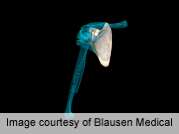(HealthDay)—Anatomic features associated with the severity of atraumatic rotator cuff tears are not associated with pain level, according to a study published in the May 21 issue of The Journal of Bone & Joint Surgery.
Warren R. Dunn, M.D., M.P.H., from University of Wisconsin in Madison, and colleagues evaluated 393 subjects with an atraumatic symptomatic full-thickness rotator-cuff tear treated with physical therapy. Tear size, retraction, superior humeral head migration, and rotator cuff muscle atrophy were used to evaluate disease severity. A 10-point visual analog scale (VAS) in the patient-reported American Shoulder and Elbow Surgeons score was used to measure pain.
The researchers found that among the patients (48 percent female; median age, 61 years) the dominant shoulder was involved in 69 percent of the cases. In nearly three-quarter of cases (72 percent) the tear involved only the supraspinatus; the supraspinatus and infraspinatus, with or without the teres minor, in 21 percent; and only the subscapularis in 7 percent. Humeral head migration was seen in 16 percent of cases. Minimal tendon retraction was seen in 48 percent of cases, midhumeral in 34 percent, glenohumeral in 13 percent, and to the glenoid in 5 percent. At baseline, the median VAS pain score was 4.4. Controlling for other baseline factors, more comorbidities (P = 0.002), lower education level (P = 0.004), and race (P = 0.041) were significant factors associated with pain on presentation. Measures of rotator cuff tear severity were not correlated with pain.
"Anatomic features defining the severity of atraumatic rotator cuff tears are not associated with the pain level," the authors write.
At least one author, or their institution, disclosed financial ties to an entity in the biomedical arena.
More information:
Abstract
Full Text (subscription or payment may be required)
Copyright © 2014 HealthDay. All rights reserved.




















